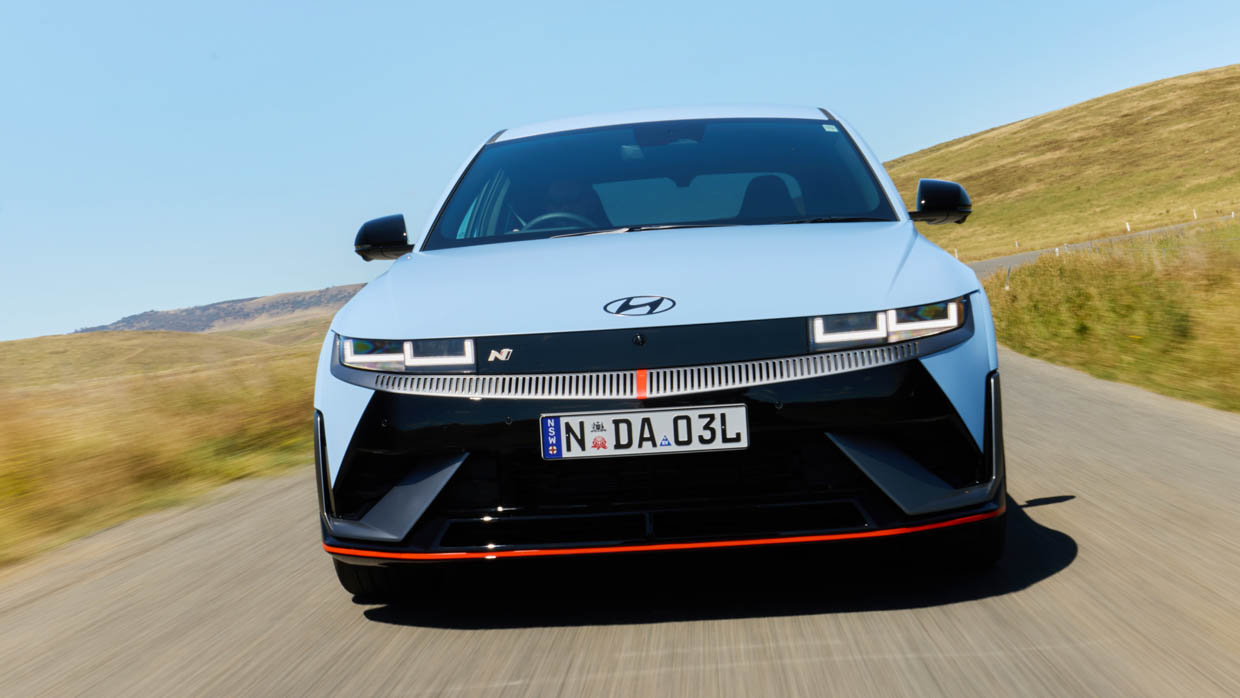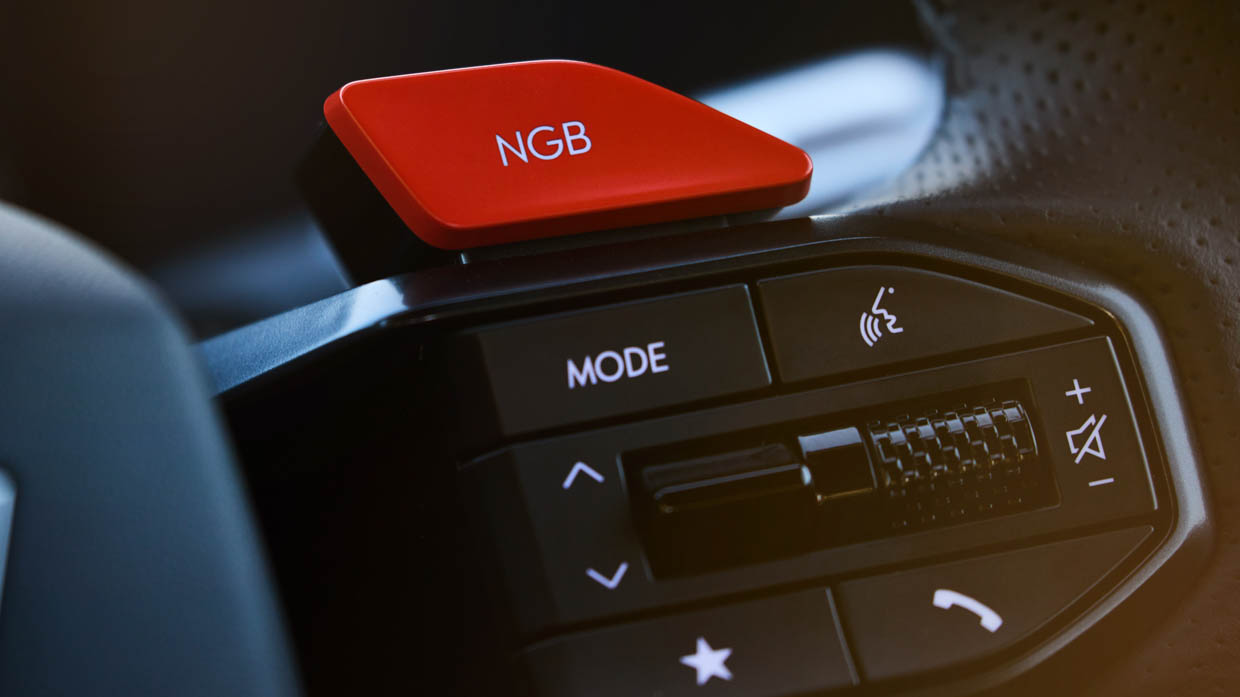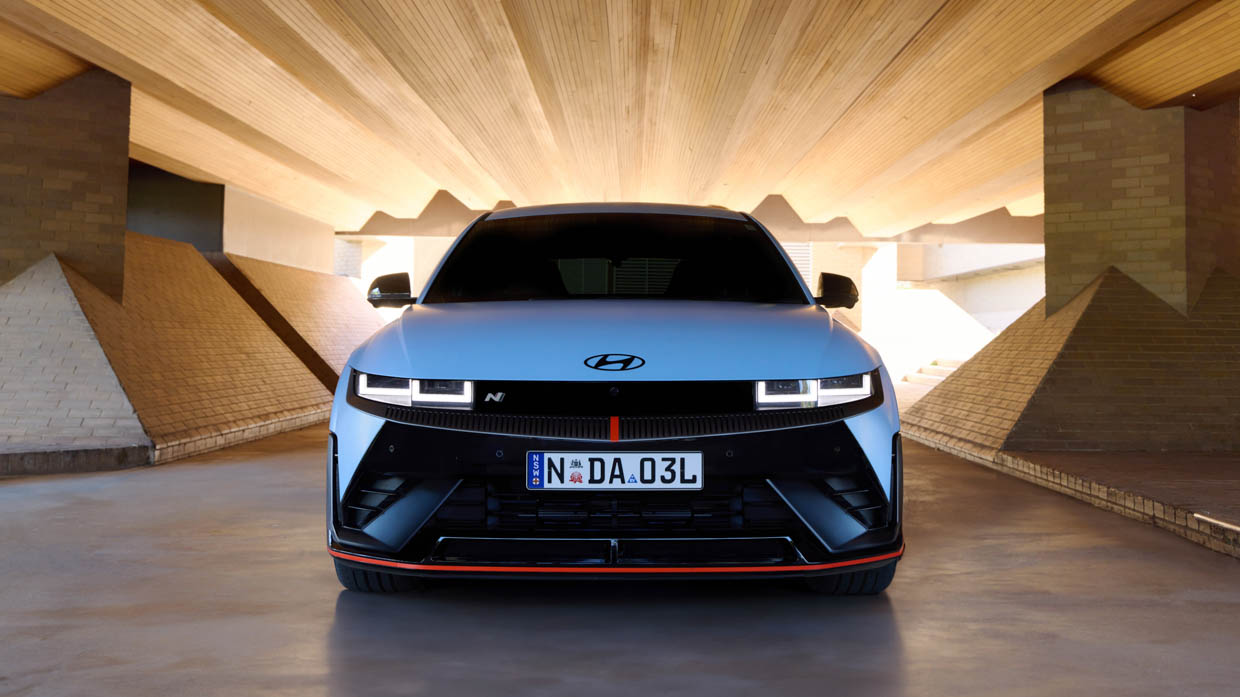-
Car Reviews
- All reviews
- Midsize SUVs
- Small cars
- Utes
- Small SUVs
- Large SUVs
- Large cars
- Sports SUVs
- Sports cars
- Vans
Latest reviews
- Car News
-
Car Comparisons
Latest comparisons
- Chasing Deals
Major achievement for EV driver engagement as Hyundai incorporates combustion-engine cues to seriously convincing and helpful effect
The first big breakthrough for making fast EVs genuinely satisfying to drive was the release of the Porsche Taycan. The second breakthrough is the new Hyundai Ioniq 5 N.
It’s a grand statement, but so’s the car: the seriously heady Ioniq 5 N is the magnum opus of Albert Biermann, N division’s controlling brain since its inception.
A $111,000 (before on-road costs), all-electric, high-performance Hyundai would have been unthinkable a decade ago, when the brand’s Golf GTI-hunting i30 N was still a rumour.

It might have a cult following, but Hyundai’s N performance brand is still fledgling enough that a convincing leap to the fully-electric era, dictated mainly by the sweeping impact of European emissions regulations on the world car industry, was far from assured.
And yet, driven first in South Korea by Chasing Cars correspondent Iain Curry and second on Australian roads – and Sydney Motorsport Park – by yours truly confirms that Hyundai is well ahead of most car manufacturers on the road to making EVs drive properly.
Tesla might lead the EV industry in sales, software and charging – all of which are meaningful and crucially important – but the well-executed Ioniq 5 N is way ahead of any Model 3 or Model Y for driver engagement and fun-factor.
With 478kW on tap from the dual-motor AWD configuration and an easy sub-4.0 second 0-100km/h time there is no shortage of power – as with most fast electric cars. To concentrate on such numbers would be to miss the point.

Unlike Tesla, which has leant hard into minimalism, both in terms of styling and the driving persona of its vehicles – even supposedly sporty ones – Hyundai has followed Porsche in going the other way.
Like the reigning best EV on the market for drivers – the Porsche Taycan – the Ioniq 5 N basically tries to imitate the dynamics of super-sorted combustion vehicles. In fact, meticulous Hyundai has gone much further than Porsche in some areas.
Biermann, who headed a crack team of engineers in developing the Ioniq 5 N despite being opaquely ‘retired’ for some years, rammed through a major decision that has been pivotal in making the Ioniq 5 N more rewarding (and easier) to drive quickly on road and track.
The squad that developed Hyundai’s dual-clutch automatic transmission, in-house, for the i30 N and Kona N petrol performance cars was ushered into the Ioniq 5 N development process.

Their mission: replicate the eight-speed dual-clutch ‘box in a fully artificial world and apply it to the software profile of the Ioniq 5 N. Sounds silly – but it really works.
It’s frankly easy to make EVs fast, but it is really, really hard to connect drivers with a sense of speed in an electric car when they are also making complex decisions while observing their own pace.
Think about tackling a country road full of hairpins quickly – or if you’re familiar with track driving, perhaps you’re charging towards a double-apex bend while trying to pass another driver.
In combustion cars, drivers have sound, vibration, gears and visual reference to the tachometer to put their speed in context, in addition to the information streaming in from the horizon.

Fast EVs – chief among them the properly rapid Tesla Model 3 Performance – dispense with most of those helpful info streams. But the Ioniq 5 N brings them back in utterly convincing fashion.
You can drive the Ioniq 5 N in relative silence as with any other EV, but one tap of the N button on the steering wheel activates a fake – but totally, sincerely believable – artificial eight-speed gear map driven through the paddle shifters on the steering wheel, plus a crackle-pop petrol exhaust note.
Fail to shift up as the RPM peaks in-gear? The Ioniq 5 N will bang against its rev limiter and not accelerate further. Try and shift down before revs have fallen appropriately? You can’t. For all intents and purposes, the EV becomes something akin to a paddle-shifted BMW M5.
If you’re scoffing, I understand – but you won’t properly understand until you try it. Hyundai’s willing to give test drives just to get people across this point.

The point is that while the Ioniq 5 N possesses the necessary rapid acceleration (and braking) of any car we rate as properly set up for hard driving, it also renews the cues that make it fun and rewarding to do so.
Some other EVs, including the Porsche, the AMG vehicles and the Abarth 500e, pipe in the noise, but none have cracked the artificial gears and vibrations that close the circle. We commend Hyundai for working this out.
Putting aside this fundamentally important tech, what of the Ioniq 5 N’s handling? It’s good, but not quite great.
The problem is weight – at about 2200kg, the Ioniq 5 N is seriously heavy. Despite looking sort of compact in photos, it’s also quite large in reality: 1940mm in width is almost 15 centimetres wider than an i30 N hatch, and that size becomes apparent on tight roads.

Dimensionally, the Ioniq 5 N is sized around its battery pack: a circa-80kWh usable skateboard nestled between the axles on a vast 3000mm wheelbase.
This pack causes the addition of considerable weight over a BMW M340i (1695kg), but it is very low set and it brings stability, most of the time – but like any EV with a huge pancake battery, inertia is impossible to avoid when pushing very hard in corners.
Hyundai has done a better job of managing the inevitable push understeer effect than most. Sticky tyres are one thing, but aggressive geometry at the tail encourages the rear end to get involved, with some lift-off oversteer accessible for the brave.
Power-out oversteer can also help overcome an occasionally recalcitrant front end, especially because the Ioniq 5 N’s bewilderingly deep tech stack offers huge opportunity to customise the dynamics.

From the moment the i30 N was released in 2018 we’ve been impressed by the standard-fit customisability in N cars, with dampers, steering, throttle, limited-slip differential aggression and exhaust note all adjustable.
All of those options remain here – fiddled for the electric age – but there are now far more attributes that can be toyed with. Torque distribution is on a slider – anything from 100% front to 100% rear, fading motor contributions in and out as your finger glides across a 12-inch touchscreen.
These settings are no gimmick: the behaviour of the car can be fundamentally altered from feeling like a bizarrely large FWD hot hatch to a balls-out rear-drive drifting maniac. Speaking of, naturally, there’s a drift mode. And a sprint mode, with requisite battery warming or cooling.
Returning to the battery, at about 80kWh usable (Hyundai, frustratingly, refuses to disclose this important metric), was all about striking a balance for N division.

The pack is still small enough to keep the weight just about acceptable to its engineers while being big enough not to embarrass the high-performance Ioniq 5 on driving range metrics…in Europe, at least.
Australia’s a bigger place and the Ioniq 5 N’s range is problematic. On the Chasing Cars real-world EV range test, we logged a realistic highway range of 396km at 20.2kWh/100km and urban range of 437km at 18.3kWh/100km.
That’s before you turn up the wick: when driving hard on country roads, you will be looking at a paltry 285km-320km of sportily-driven EV range. There are genuinely few routes that get you out of the Sydney basin to great roads – and back again – without needing to charge.
We would not be surprised if an eventual update to this car brings a 100kWh battery with improved efficiency which will go some way to fixing this issue, but we aren’t there yet.

At least the Ioniq 5 N can charge seriously fast when you do need to stop. Craft your pitting around a route that draws near to 350kW ultra-rapid chargers and you can replenish four-fifths of your range in about 20 minutes: long enough to recharge the driver without things getting boring.
Charging is also a factor for heavy-duty driving on track. Hyundai has generously installed chargers at Sydney Motorsport Park and for our testing sessions, they worked precisely as designed.
Biermann’s team delivered on a so-called ‘20/20/20’ principle for tracking the Ioniq 5 N: drive (hard) for 20 minutes, charge and rest for 20 minutes, back on track for another 20 minutes.
Provided your desired track has 150kW or better chargers, as SMSP now does, this works just fine.

There’s also the price to contend with. At $111,000 (before on-road costs), the Ioniq 5 N is realistically good value – no other EV comes close to this sophistication at this money.
You’d need to spend double – $224,000 before on-roads – on the air-sprung Porsche Taycan 4S Cross Turismo to feel like you’re doing better than the Ioniq 5 N’s dynamics with similar practicality. Some testers prefer the Hyundai. I don’t, but to get close at half the cash is impressive.
Still…despite the Ioniq 5 N being as academically and genuinely brilliant as it is, Hyundai knows full well that a six-figure price is a big ask regardless.
That’s particularly true considering that the Ioniq 5 N’s development budget has largely been spent under the skin. The interior atmosphere is pleasant enough, but not luxurious. The heated and cooled seats are manual. Materials are fine, nothing more.

A huge back seat and decently large boot are hallmarks of the EV-specific platform, though an enlarged front motor (pinched from the rear axle of a Genesis GV60) eliminates the standard Ioniq 5’s frunk.
Warranty is Hyundai’s standard five year, unlimited kilometre plan, though the battery is warranted to retain at least 70 percent of its original capacity for eight years or 160,000km – that’s important if you’re planning heavy use of ultra-rapid chargers.
Sales expectations in Australia for the Ioniq 5 N have been set realistically as a result – maybe 100 or 200 cars per year.
We mentioned the three-litre petrol BMW M340i before. That’s because we see the combustion, AWD 3 Series as this car’s true direct rival.
At $106,200 before on-road costs, the BMW is similarly priced with a similar mission. We think people that like the M340i would also like the Ioniq 5 N. Put aside other EVs – to be playing in the same ballpark as the hugely-rated M340i is a massive achievement.
Key specs (as tested)
About Chasing cars
Chasing Cars reviews are 100% independent.
Because we are powered by Budget Direct Insurance, we don’t receive advertising or sales revenue from car manufacturers.
We’re truly independent – giving you Australia’s best car reviews.
The estimate provided does not take into account your personal circumstances but is intended to give a general indication of the cost of insurance, in order to obtain a complete quote, please visit www.budgetdirect.com.au. Estimate includes 15%^ online discount.
^Conditions Apply
Budget Direct Insurance arranged by Auto & General Services Pty Ltd ACN 003 617 909(AGS) AFSL 241 411, for and on behalf of the insurer, Auto & General Insurance Company Limited(ABN 42 111 586 353, AFSL 285 571).Because we don’t know your financial needs, we can’t advise you if this insurance will suit you. You should consider your needs and the Product Disclosure Statement before making a decision to buy insurance. Terms and conditions apply.
Indicative quote based on assumptions including postcode , 40 year old male with no offences, licence suspensions or claims in the last 5 years, a NCD Rating 1 and no younger drivers listed. White car, driven up to 10,000kms a year, unfinanced, with no modifications, factory options and/or non-standard accessories, private use only and garaged at night.
^Online Discounts Terms & Conditions
1. Discounts apply to the premium paid for a new Budget Direct Gold Comprehensive Car Insurance, Third Party Property Only or Third Party Property, Fire & Theft Insurance policy initiated online on or after 29 March 2017. Discounts do not apply to optional Roadside Assistance.
2. Discounts do not apply to any renewal offer of insurance.
3. Discounts only apply to the insurance portion of the premium. Discounts are applied before government charges, taxes, levies and fees, including instalment processing fees (as applicable). The full extent of discounts may therefore be impacted.
4. We reserve the right to change the offer without notice.